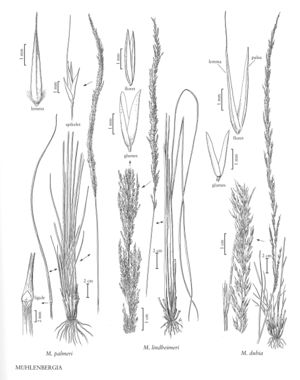Muhlenbergia dubia
Plants perennial; densely cespitose, not rhizomatous. Culms 30-100 cm, erect, rounded near the base, not rooting at the lower nodes; internodes glabrous for most of their length, minutely pubescent to hirtellous below the nodes. Sheaths longer than the internodes, smooth or scabridulous, not becoming spirally coiled when old; ligules 4-10 mm, membranous, firm, acute, lacerate; blades 10-60 cm long, 1-2 mm wide, usually involute (occasionally flat), scabrous abaxially, hispidulous adaxially. Panicles 10-40 cm long, 0.6-2.4 cm wide, contracted, grayish-green; primary branches 0.2-7 cm, diverging up to 40° from the rachises, stiff, spikelet-bearing to the base; pedicels 0.1-6 mm, strongly divergent, hispidulous. Spikelets 3.8-5 mm, grayish-green. Glumes equal, (1.8) 2-3 mm, shorter than the florets, glabrous and smooth proximally, scabridulous distally, faintly 1-veined, acute; lemmas 3.8-5 mm, narrowly lanceolate, calluses hairy, hairs to 0.5 mm, lemma bodies glabrous and smooth below, scabrous distally, apices acuminate, unawned or awned, awns to 6 mm, straight; paleas 3.8-5 mm, narrowly lanceolate, glabrous below, acuminate; anthers 1.5-2.2 mm, greenish. Caryopses 2.5-3.5 mm, fusiform, brownish. 2n = 40, 50.
Distribution
Ariz., N.Mex., Tex.
Discussion
Muhlenbergia dubia grows on steep slopes, ridge tops, limestone rock outcrops, and along draws, at elevations of 1500-2300 m. Its range extends into northern Mexico. It resembles M. rigens, but differs in having looser, contracted (but not spikelike) panicles, longer ligules, olivaceous anthers, and generally longer lemmas.
Selected References
None.
Lower Taxa
"decumbent" is not a number.
